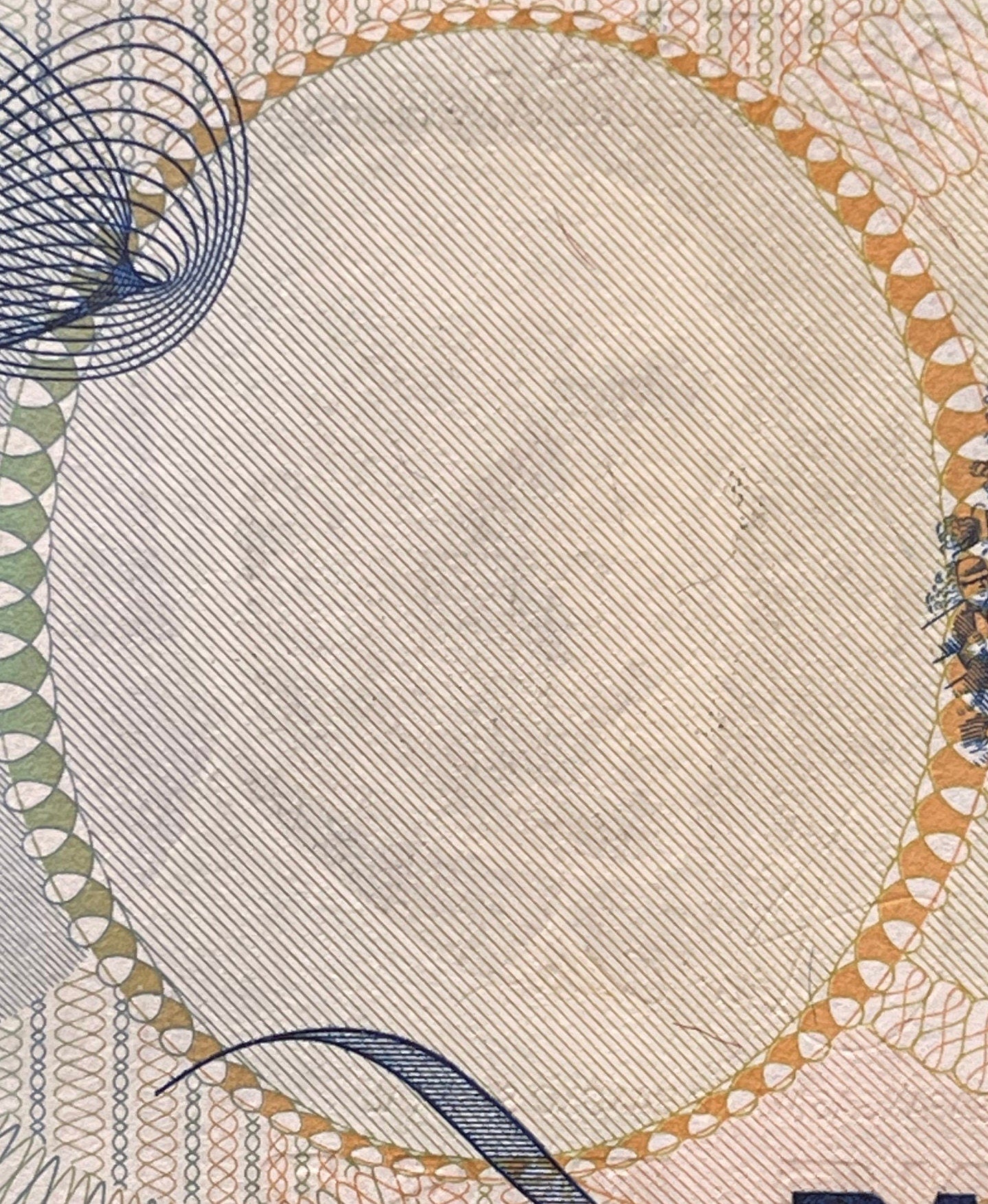elemintalshop
Philippines Declaration of Independence on Emilio Aguinaldo's Balcony & José Rizal 2 Piso Authentic Banknote Money for Collage (Bautista)
Philippines Declaration of Independence on Emilio Aguinaldo's Balcony & José Rizal 2 Piso Authentic Banknote Money for Collage (Bautista)
Couldn't load pickup availability
Philippine Declaration of Independence on Emilio Aguinaldo's Balcony & José Rizal 2 Piso Authentic Banknote Money for Jewelry and Collage (Ambrosio Bautista)
Commemorative banknote issue: Papal Visit of John Paul II
Reverse: Depiction of the declaration of independence of the Philippines in 1898 on Revolutionary Forces General Emilio Aguinaldo's balcony. The Act of the Declaration of Independence was prepared, written, and read by Ambrosio Rianzares Bautista.
Lettering: PAHAYAG NG KASARINLAN NG PILIPINAS NOONG HUNYO 12, 1898
(BALKONAHE NG MANSYONG AGUINALDO)
DALAWANG PISO
Translation: Declaration of Independence of the Philippines June 12, 1898
(Balcony of Aguinaldo's Mansion)
Two pesos
Obverse: Jose Rizal at left, overprint Ang Bagong Lipunan at centre right and black commemorative overprint, Papal seal at lower right
Lettering: REPUBLIKA NG PILIPINAS
ANG SALAPING PAPEL NA ITO AY ISANG BAYARIN NG
BANGKO SENTRAL
AT LUBOS NA PINANANAGUTAN NG PAMAHALAAN NG REPUBLIKA NG PILINAS
ANG BAGONG LIPUNAN
PAGDALAW NG PAPA JUAN PABLO II PEB 17-22, 1981
JOSE RIZAL
DALAWANG PISO
ANG PAPEL NA ITO AY SALAPING UMIIRAL SA PILINAS AT PAMBAYAD SA LAHAT NG URI NG PAGKAKAUTANG
Translation:
Republic of the Philippines
This note is a liability of the Central Bank and is fully guaranteed by the Government of the Republic of the Philippines
The New Society
Visit of Pope John Paul II February 17-22, 1981
Two pesos
This note is legal tender in the Philippines and payment to all kind of debt
Comments: Commemorative overprint at center right of P# 159b.
Features
Issuer Philippines
Issuing bank Central Bank of the Philippines
Period Republic (1946-date)
Type Commemorative note
Year 1981
Value 2 Piso (2 PHP)
Currency Piso (1967-date)
Composition Paper (90% Cotton, 10% Linen)
Size 160 × 66 mm
Shape Rectangular
Demonetized 3 February 1996
Number N# 206426
References P# 166
Wikipedia:
The Philippine Declaration of Independence (Filipino: Pagpapahayag ng Kasarinlan ng Pilipinas; Spanish: Declaración de Independencia de Filipinas) was proclaimed by Filipino revolutionary forces general Emilio Aguinaldo on 12 June 1898 in Cavite el Viejo (present-day Kawit, Cavite), Philippines. It asserted the sovereignty and independence of the Philippine Islands from the colonial rule of Spain.
History
In 1896, the Philippine Revolution began. In December 1897, the Spanish government and the revolutionaries signed a truce, the Pact of Biak-na-Bato, requiring that the Spanish pay the revolutionaries $MXN800,000 and that Aguinaldo and other leaders go into exile in Hong Kong. In April 1898, at the outbreak of the Spanish–American War, Commodore George Dewey aboard the U.S.S. Olympia sailed into Manila Bay leading the Asiatic Squadron of the U.S. Navy. On 1 May 1898, the United States defeated the Spanish in the Battle of Manila Bay. Emilio Aguinaldo decided to return to the Philippines to help American forces defeat the Spaniards. The U.S. Navy agreed to transport him back aboard the USS McCulloch, and on May 19, he arrived in Cavite.
The Proclamation on 12 June
Independence was proclaimed on 12 June 1898 between four and five in the afternoon in Cavite at the ancestral home of General Emilio Aguinaldo some 30 kilometres (19 mi) south of Manila. The event saw the unfurling of the Flag of the Philippines, made in Hong Kong by Marcela Agoncillo, Lorenza Agoncillo, and Delfina Herboza, and the performance of the Marcha Filipina Magdalo, as the national anthem, now known as Lupang Hinirang, which was composed by Julián Felipe and played by the San Francisco de Malabon marching band.
The Act of the Declaration of Independence was prepared, written, and read by Ambrosio Rianzares Bautista in Spanish. The Declaration was signed by 98 people, among them a United States Army officer who witnessed the proclamation. The final paragraph states that there was a "stranger" (stranger in English translation—extranjero in the original Spanish, meaning foreigner) who attended the proceedings, Mr. L. M. Johnson, described as "a citizen of the U.S.A., a Colonel of Artillery". Despite his prior military experience, Johnson had no official role in the Philippines.
Ratification
The proclamation of Philippine independence was, however, promulgated on 1 August, when many towns had already been organized under the rules laid down by the Dictatorial Government of General Aguinaldo. 190 municipal presidents of different towns from 16 provinces—Manila, Cavite, Laguna, Batangas, Bulacan, Bataan, Infanta, Morong, Tayabas, Pampanga, Pangasinan, Mindoro, Nueva Ecija, Tarlac, La Union and Zambales—ratified the Proclamation of Independence in Bacoor, Cavite.
Later at Malolos, Bulacan, the Malolos Congress modified the declaration upon the insistence of Apolinario Mabini who objected to that the original proclamation essentially placed the Philippines under the protection of the United States.
********
Wikipedia:
José Rizal
José Protasio Rizal Mercado y Alonso Realonda (Spanish pronunciation: [xoˈse riˈsal]; June 19, 1861 – December 30, 1896) was a Filipino nationalist and polymath during the tail end of the Spanish colonial period of the Philippines. He is tagged as the national hero (pambansang bayani) of the Filipino people. An ophthalmologist by profession, Rizal became a writer and a key member of the Filipino Propaganda Movement, which advocated political reforms for the colony under Spain.
He was executed by the Spanish colonial government for the crime of rebellion after the Philippine Revolution, inspired in part by his writings, broke out. Though he was not actively involved in its planning or conduct, he ultimately approved of its goals which eventually led to Philippine independence.
He is widely considered one of the greatest heroes of the Philippines and has been recommended to be so honored by an officially empaneled National Heroes Committee. However, no law, executive order or proclamation has been enacted or issued officially proclaiming any Filipino historical figure as a national hero. He was the author of the novels Noli Me Tángere and El filibusterismo, and a number of poems and essays.
Share



















